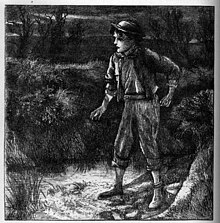
A hound is a type of hunting dog used by hunters to track or chase prey.

Fox hunting is a traditional activity involving the tracking, chase and, if caught, the killing of a fox, normally a red fox, by trained foxhounds or other scent hounds. A group of unarmed followers, led by a "master of foxhounds", follow the hounds on foot or on horseback.

The Hash House Harriers is an international group of non-competitive running social clubs. An event organized by a club is known as a Hash or Run, or a Hash Run. A common denominal verb for this activity is Hashing, with participants calling themselves Hashers. Male members are referred to as Harriers and females are known as Harriettes.

Beagling is mainly the hunting of hares and rabbits by beagles using their strong sense of smell. A beagle pack is usually followed on foot, but in a few cases mounted. Beagling is often enjoyed by 'retired' fox hunters who have either sustained too many injuries or lost the agility to ride horseback, or who enjoy the outdoors and the camaraderie of the hunt. It is also traditionally a way for young men and women to learn how to handle hounds on a smaller scale before they go on to hunt with foxhounds.

The Hunt Saboteurs Association (HSA) is a United Kingdom organisation that uses hunt sabotage as a means of direct action to stop fox hunting. It was founded in 1963, with its first sabotage event occurring at the South Devon Foxhounds on 26 December 1963.
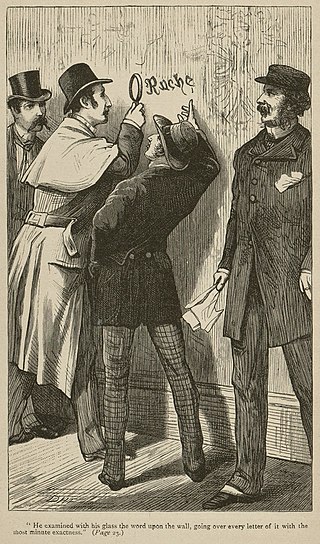
A red herring is something that misleads or distracts from a relevant or important question. It may be either a logical fallacy or a literary device that leads readers or audiences toward a false conclusion. A red herring may be used intentionally, as in mystery fiction or as part of rhetorical strategies, or may be used in argumentation inadvertently.
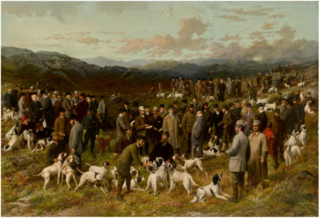
A field trial is a competitive event for gun dogs. Field trials are conducted for pointing dogs and setters, retrievers and spaniels, with each assessing the different types various working traits. In the United States, field trials are also conducted for basset hounds, beagles, and dachshunds.

The Segugio Italiano is either of two Italian breeds of dog of scent hound type, the wire-haired Segugio Italiano a Pelo Forte or the short-haired Segugio Italiano a Pelo Raso. Apart from the coat type, they are closely similar, and in some sources may be treated as a single breed; the Fédération Cynologique Internationale and the Ente Nazionale della Cinofilia Italiana treat them as separate. They are also genetically close to the other two Italian scent hound breeds, the Segugio Maremmano and the Segugio dell'Appennino. They are traditionally used for hunting hare, but may also be used in boar hunts.

In the United Kingdom, the term hunting with no qualification generally refers to hunting with hounds, e.g. normally fox hunting, stag (deer) hunting, beagling, or minkhunting, whereas shooting is the shooting of game birds. What is called deer hunting elsewhere is deer stalking. According to the British Association for Shooting and Conservation (BASC) over a million people a year participate in shooting, including stalking, shooting, hunting, clay shooting and target shooting. Firearm ownership is regulated in the UK by licensing. Provisions exist for those without a Firearm or Shotgun certificate to shoot under the supervision of a certificate holder.
Thames Hare and Hounds is the oldest adult cross-country running club in the world, based on the Roehampton end of Wimbledon Common, adjacent to Richmond Park, and draws runners from across south-west London. Both the men's and women's teams compete in the Surrey Cross Country League, division one; the club also fields teams in road races and relays. Thames host races in Richmond Park and on Wimbledon Common, in particular the cross-country Oxford–Cambridge Varsity Match, held each year since 1880 on Wimbledon Common after the end of Michaelmas term.
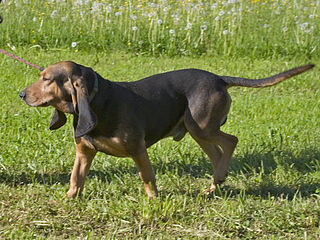
The Bruno Jura Hound is a breed of scenthound from the Jura Mountains on the French-Swiss border.

The Taigan, and also known as Kyrgyz Taighany, Mongolian Taiga dog is a breed of sighthound from Kyrgyzstan. The Taigan is found in the alpine Tian Shan region of Kyrgyzstan on the border with China, it is closely related to the Tazy and the Saluki.

The Sabueso Español or Spanish Hound is a scenthound breed with its origin in the far north of Iberian Peninsula. This breed has been used in this mountainous region since hundreds of years ago for all kind of game: wild boar, hare, brown bear, wolf, red deer, fox, roe deer and chamois. It is an exclusive working breed, employed in hunting with firearms.

The bloodhound is a large scent hound, originally bred for hunting deer, wild boar, rabbits, and since the Middle Ages, for tracking people. Believed to be descended from hounds once kept at the Abbey of Saint-Hubert, Belgium, in French it is called, le chien de Saint-Hubert.
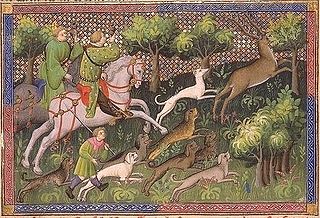
Rache, also spelled racch, rach, and ratch, from Old English ræcc, linked to Old Norse rakkí, is an obsolete name for a type of hunting dog used in Great Britain in the Middle Ages. It was a scenthound used in a pack to run down and kill game, or bring it to bay. The word appears before the Norman Conquest. It was sometimes confused with 'brache', which is a French derived word for a female scenthound.
A limer, or lymer, was a kind of dog, a scenthound, used on a leash in medieval times to find large game before it was hunted down by the pack. It was sometimes known as a lyam hound/dog or lime-hound, from the Middle English word lyam, meaning 'leash'. The French cognate limier has sometimes been used for the dogs in English as well. The type is not to be confused with the bandog, which was also a dog controlled by a leash, typically a chain, but was a watchdog or guard dog.
Trail hunting is a legal, although controversial, alternative to hunting animals with hounds in Great Britain. A trail of animal urine is laid in advance of the 'hunt', and then tracked by the hound pack and a group of followers; on foot, horseback, or both.
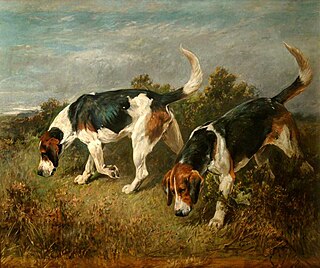
The Buckhound was a breed of now extinct scent hound from England; they were used to hunt fallow deer in packs.

The West Country Harrier, sometimes called Somerset Harrier, is a breed of scent hound from the south west of England that is used to hunt hare in packs. The West Country Harrier is often considered to be a variety of the more common Harrier breed, which is sometimes referred to as the Studbook Harrier.

Bassets are a sub-type of scenthound deliberately bred with short legs, that are used for hunting where the hunters accompany the hunting hounds on foot.

